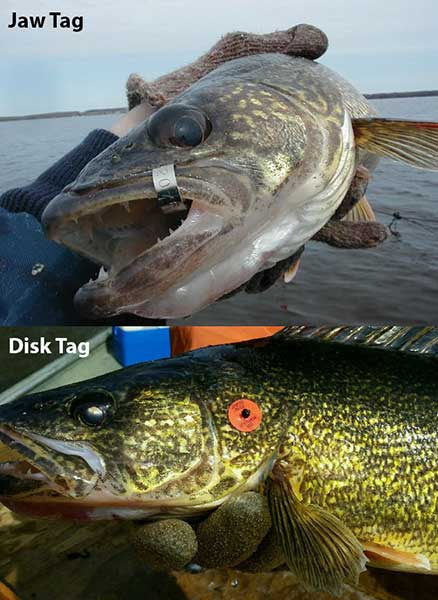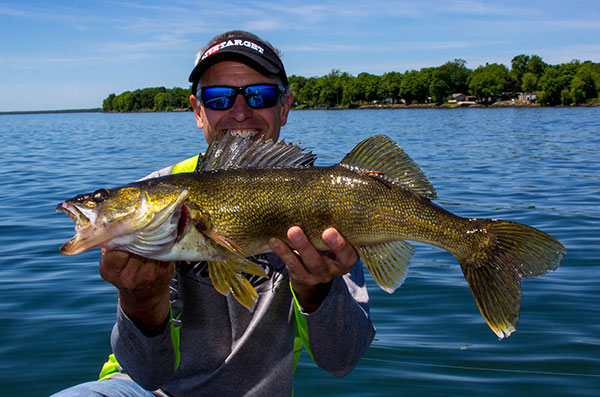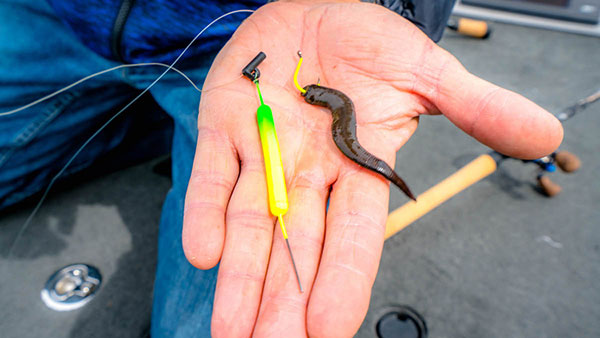- Details
MDNR Report
 Report Saginaw Walleyes to DNR; Win a Chance for $100
Report Saginaw Walleyes to DNR; Win a Chance for $100
The Michigan DNR jaw-tagged 3,000 walleyes in a number of Saginaw Bay tributary rivers recently and is now asking anglers to collect and report information on tagged fish they catch.
The DNR has jaw-tagged more than 100,000 walleyes in the Saginaw Bay area since 1981 as part of a long-term research project to monitor survival and harvest rates and to learn about walleye movement. Each tag is stamped with a unique identification number and a post office box address. Anglers who catch a tagged walleye can report their catch by mail using the address on the tag, by calling the DNR Bay City Customer Service Center at 989-684-9141, or online by visiting www.Michigan.gov/taggedfish.
- Details
By Chip Leer
 Target High-Percentage Transitions for Walleyes All Summer
Target High-Percentage Transitions for Walleyes All Summer
Midsummer is a time of plenty in walleye fisheries around the country. Habitat and forage options are at seasonal peaks, allowing hungry ‘eyes to scatter more so than at any other time of year.
Still, you’ll often find 80 percent of the fish in 20 percent of the water. By targeting classic fish-holding edges with proven presentations, you can consistently find and catch walleyes while other anglers scramble aimlessly around the lake.
- Details
By Chip Leer
Wildside Media
 Surefire Strategies for Post-Spawn Walleyes
Surefire Strategies for Post-Spawn Walleyes
Late spring walleye fishing can be ridiculously easy or incredibly frustrating, depending on the conditions and your approach.
Here are four proven patterns to help you match the conditions and catch more fish on every trip:
Less Than 12 Feet Of Water
Drag A Jig: Drifting or slow-trolling a leadhead on bottom is one of my favorite ways to cover large flats or emerging weed growth. Northland Fishing Tackle’s Stand-Up Fire-Ball is the jig for the job: the 45-degree angled eye lets you drag without fouling, and positions the bait in a natural, slightly elevated manner. I like tipping with a shiner, but a leech or half-crawler is also deadly. Experiment with distance from the boat, as well as dragging and snapping motions until the fish reveal their preference. The weight of the jig depends on wind and bait, but generally works best using an 1/8 to ¼ ounce.
- Details
(Provided by MDNR)
 Those who fish Michigan's Great Lakes may catch a walleye with one of two types of tags: a jaw tag or a disk tag (both pictured here). Those who do are asked to report it to the DNR.
Those who fish Michigan's Great Lakes may catch a walleye with one of two types of tags: a jaw tag or a disk tag (both pictured here). Those who do are asked to report it to the DNR.
Those who fish Michigan's Great Lakes may catch a walleye with one of two types of tags: a jaw tag or a disk tag (both pictured here). Those who do are asked to report it to the DNR.
The Michigan DNR has jaw-tagged another 3,000 walleyes in a number of Saginaw Bay tributary rivers and wants anglers who catch them to collect information and report it to the DNR.
The DNR has tagged more than 100,000 walleyes in the Saginaw Bay area since 1981. Jaw tagging is part of a long-term research project to monitor survival and harvest rates and to learn about walleye movement. The program depends on anglers to report when they catch a tagged walleye, catch location, as well as the fishís length, weight (if known) and tag identification number. Once reported, anglers will receive a letter back detailing the history of their fish.





